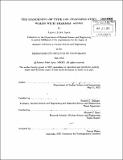The hardening of Type 316L stainless steel welds with thermal aging
Author(s)
Ayers, Lauren Juliet
DownloadFull printable version (3.097Mb)
Other Contributors
Massachusetts Institute of Technology. Dept. of Nuclear Science and Engineering.
Advisor
Ronald G. Ballinger.
Terms of use
Metadata
Show full item recordAbstract
Welded stainless steel piping is a component of boiling water reactors (BWRs). Reirculation and other large diameter piping are fabricated from Type 304 or 316 stainless steels. Delta ferrite is present in welds, because of its ability to reduce hot cracking; however, its presence can make the microstructure unstable. Delta ferrite is susceptible to spinodal decomposition, a process during which the given material separates into two phases with different compositions and properties, which can lead to brittleness and weakness in the steel. The H.H. Uhlig Corrosion Laboratory is investigating the effect of thermal aging on the physical properties of stainless steel piping. Stainless steel piping, of the same standards of that used in boiling water reactors, was welded and aged at temperatures of 300-400*C for 1,000 - 40,000 hours. The properties of the material were examined using several techniques, including Vickers hardness testing, to evaluate the evolution of hardness of the material, Charpy V-notch testing, to measure the evolution of toughness, and tensile testing. This thesis will focus on the variations in hardness with respect to aging time and location within the weld. Both a low ferrite series (FN=10) and a high ferrite series (FN=13) of Type 316L stainless steel welds were examined for the purposes of this paper. For each series, three materials were tested: an as welded material, a material that was aged at 400°C for 1000 hours, and a material that was aged at 400*C for 5000 hours. A two-dimensional Vickers hardness map was taken of each sample so that how hardness varies within the weld and heat affected zone can be understood. Nanoindentation was also done over small regions of each weld sample, to analyze whether the hardness changes over the dendrite boundaries. The overall hardness of the welds is found to increase to 1000 h and subsequently decrease slightly to 5000 h. The hardness map for each sample was found to be roughly symmetric across the weld centerline, but the hardness values were not found to be consistent along the weld centerline. In general the weld is harder when narrower, and softens as the weld widens. This trend was observed regardless of aging time or ferrite number.
Description
Thesis (S.B.)--Massachusetts Institute of Technology, Dept. of Nuclear Science and Engineering, 2012. Cataloged from PDF version of thesis. Includes bibliographical references (p. 34-35).
Date issued
2012Department
Massachusetts Institute of Technology. Department of Nuclear Science and EngineeringPublisher
Massachusetts Institute of Technology
Keywords
Nuclear Science and Engineering.